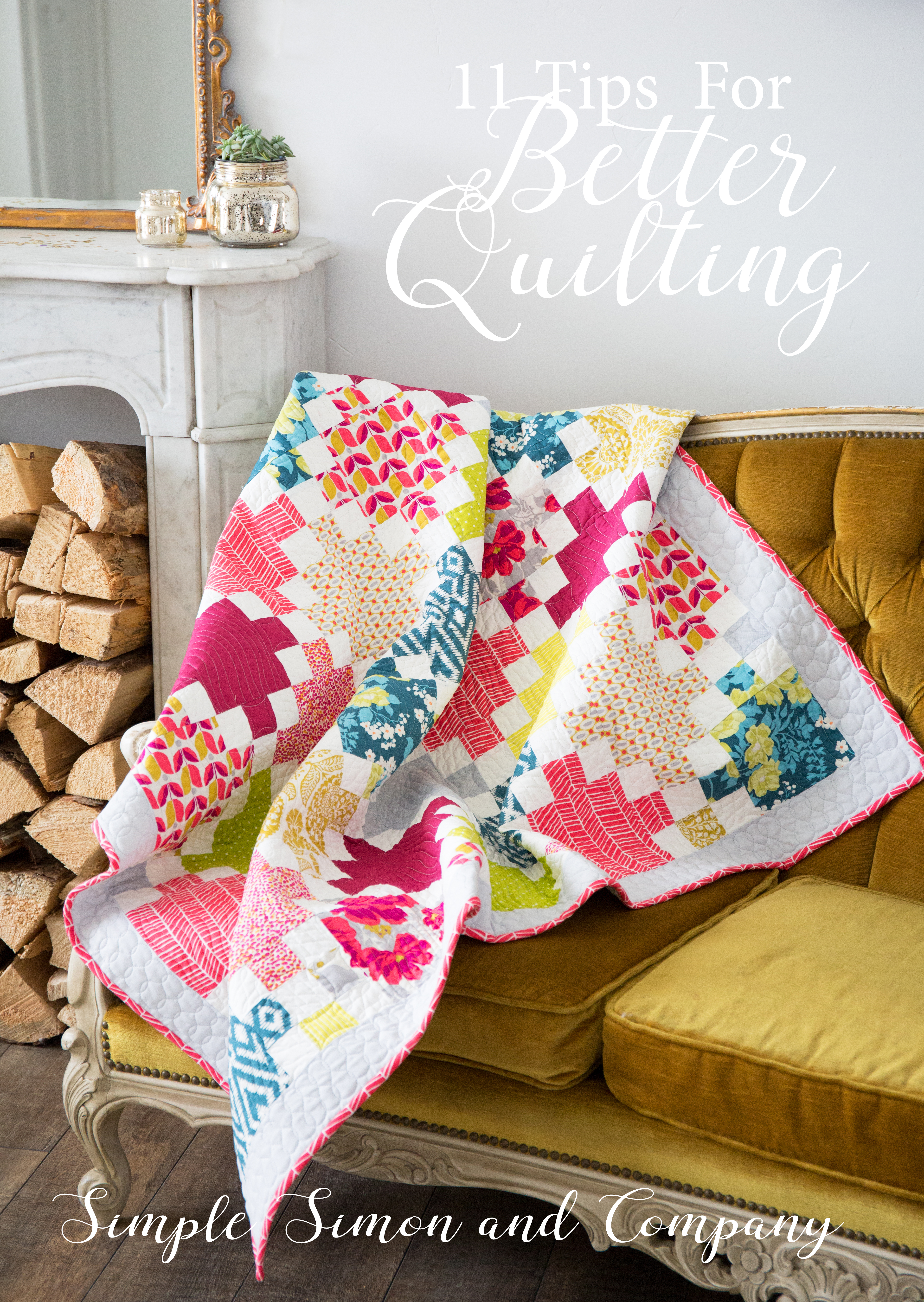 1. Use the right tools for the job. Having a small sewing kit just for quilting can help with not only organization but also with the time it takes to quilt. You aren’t rounding up your tools every time you need to do a project…but they are always together and always on hand. Some of my favorites are shown below including wonder clips (*affiliate link*) that I think are worth their weight in gold when binding a quilt.
1. Use the right tools for the job. Having a small sewing kit just for quilting can help with not only organization but also with the time it takes to quilt. You aren’t rounding up your tools every time you need to do a project…but they are always together and always on hand. Some of my favorites are shown below including wonder clips (*affiliate link*) that I think are worth their weight in gold when binding a quilt.

2. Better cutting equals a better quilt. I know a lot of people talk about accurate seam allowances (and we will below) but cutting is the very first piece to the puzzle. Make sure you are using a good quality cutting mat, rotary cutter and ruler. I am a big fan of the Kai rotary cutters (*affiliate link*) these days. They are super sharp and cut so smoothly and a big bonus is that they are not that expensive! Another tip to give is to always cut your fabric straight of grain (unless pattern suggests using fabric on bias). Getting off grain can make piecing hard because the fabric will stretch when you don’t want it to.
 3. Use accurate seam allowances. The standard in quilting is a “scant” 1/4 inch seam allowance, which is a stable seam allowance but doesn’t waste too much fabric. Add in the fact that in quilting most seams are then sewn over in an opposite direction–and 1/4″ has become the standard to aim for. There are multiple ways to get that specific seam allowance. You can buy a 1/4″ foot, or some sewing machines have a 1/4″ setting. You can check with your sewing machine manual to see if your own machine has this setting. Or when all else fails, get a piece of washi tape and mark a line on your sewing machine.
3. Use accurate seam allowances. The standard in quilting is a “scant” 1/4 inch seam allowance, which is a stable seam allowance but doesn’t waste too much fabric. Add in the fact that in quilting most seams are then sewn over in an opposite direction–and 1/4″ has become the standard to aim for. There are multiple ways to get that specific seam allowance. You can buy a 1/4″ foot, or some sewing machines have a 1/4″ setting. You can check with your sewing machine manual to see if your own machine has this setting. Or when all else fails, get a piece of washi tape and mark a line on your sewing machine.
4. Quilt faster using chain piecing. If you are making a quilt that calls for making the same block over and over you can assembly line the quilt. For example, sew all of block #1 to #2 in a long, long chain. Then press open and stitch block #3 to the first two sewn. It saves so much time in the long run. HERE is an excellent tutorial that can help you!

5. Nest your seams. Nesting your seams is a process of pressing seams in different directions on the back of your patchwork that serves several purposes. It reduces bulk on the back of the quilt top and also helps to keep the seams in straighter lines. Here is a great graphic on how to nest your seams if you are sewing a nine patch block taken from our book.
 6. Pressing versus ironing. liZ wrote a whole post on pressing versus ironing but the techniques in it really will help you become a faster quilter. Check out the whole tutorial HERE.
6. Pressing versus ironing. liZ wrote a whole post on pressing versus ironing but the techniques in it really will help you become a faster quilter. Check out the whole tutorial HERE.

7. Sew smaller sections first. When sewing a quilt, I like to sew 2-3 rows at a time and then move to another 2-3 row section. I think it keeps the quilt straighter as I am sewing it together.
8. Square up patchwork at each step. I know that squaring up patchwork takes more time while making a quilt, but it really does give better results. It keeps each patchwork block equal and keeps the quilt straight and square. Here is a great tutorial on squaring up patchwork.

9. Practice mitered corners. One of my first struggles when quilting was getting perfect mitered corners….and I think the key is practice, practice and practice! HERE is a tutorial if you need one.

10. Measure your quilt before adding sashing and borders. Because there are so many factors that go into a quilt, I always measure the quilt before adding sashings and borders. Then I can add borders and sashings that fit my quilt perfectly.

11. Quilting is imperfectly perfect. This quote is a saying that I have to remind myself of all the time. And I truly believe it. Quilting is a handmade art…and it is never going to be perfect. So give yourself a break if you have two of the same colored blocks too close to each other, or even if there is a mistake in the quilt. It’s all part of the quilting process.

